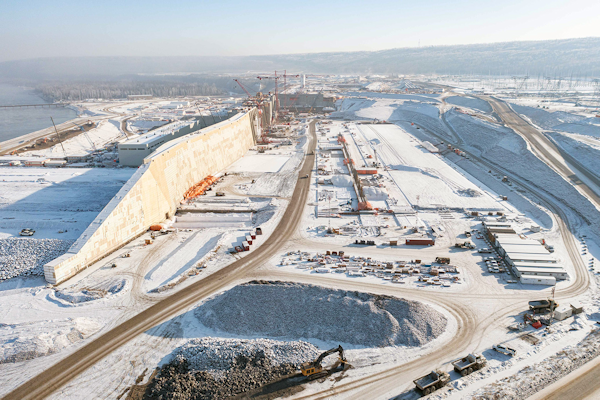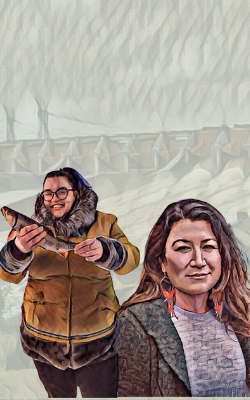SEJournal Online is the digital news magazine of the Society of Environmental Journalists. Learn more about SEJournal Online, including submission, subscription and advertising information.
 |
| Site C dam under construction in northern British Columbia in November 2022. Local First Nations and other opponents fought this project for decades. Photo: Courtesy of BC Hydro. |
Feature: Exploring the Impacts of Hydroelectric Megaprojects on Indigenous Lands
By Farha Akhtar
Last spring, the West Moberly First Nations agreed to settle out of court instead of continuing to pursue legal action against the most expensive dam in Canadian history. Following the official announcement, Chief Roland Willson told reporters, "We've, as a community, come to a realization that they're not stopping. [We're] painfully aware that we've lost the valley."
And with that, it all seemed to come to an abrupt end. Despite decades of community opposition, judicial reviews and lawsuits, the 16 billion Canadian dollar (US$11.6 billion) hydroelectric megaproject — the third on British Columbia’s Peace River — was going ahead.
Site C dam will flood roughly 5,550 hectares of land, an inundation that the West Moberly First Nations say will essentially cut them off from their traditional hunting and fishing areas and forever alter their ancestral lands.
In a government press release, British Columbia’s minister of energy, mines and low carbon innovation, Bruce Ralston, praised the West Moberly First Nations for negotiating with BC Hydro, the government of Canada and the provincial government “in the spirit of reconciliation.”
His words felt flat to me. Is this what reconciliation looks like?
Reconsidering consequences
The narrative of mega-hydro development, resistance and reluctant acceptance is something that often plays out here in Canada.
While countries like the United States step away from massive hydropower projects, Canada seems to sprint towards them. In the quest to cut greenhouse gas emissions, we frequently turn to this so-called green, clean, renewable solution to address our future energy needs and meet our green energy transition strategy.
But is hydropower truly an equitable and environmentally sound solution?
Aimée Craft, a University of Ottawa law professor and an internationally recognized expert in Indigenous laws, treaties and water, urges us to reconsider that notion.
‘It’s really important to think about hydro in the
context of First Nations’ territory and not … in
terms of these remote untouched landscapes
that are open for extraction without consequence.’
— Aimée Craft
“It’s really important to think about hydro in the context of First Nations’ territory,” Craft says, “and not think about hydro in terms of these remote untouched landscapes that are open for extraction without consequence.”
I wanted to explore some of these consequences through my podcast documentary, “Submerged: Indigenous Communities and Mega-Hydro Projects.”
My goal was to present a counternarrative. To bring the voices of those affected by these projects to the forefront. To share with the listener their stories of loss, defiance and resilience. To capture their emotion, the timbre and tone of their voices, and the sound of the mighty rivers we try to harness. I chose the medium of audio storytelling because I wanted to engage with the listener and create an intimate experience with their senses.
However, I did not expect or anticipate that in the process of pursuing this project, I would also confront my own ignorance.
The loss of lands, livelihoods, culture
Large-scale dams and hydroelectric projects have massive environmental impacts, from changing microclimates to altering the way the Earth rotates. [See sidebar below for more examples.]
 |
| Cover art for the “Submerged” podcast documentary, showing featured guests Amy Norman, left, and Aimée Craft. Digital artwork by Fred Reibin. |
They also have significant social impacts, including the displacement of between 40 million and 80 million people worldwide.
I’d always thought I understood the reasons why Indigenous communities in particular resist projects of this scale: the loss of lands, livelihoods and culture. But in producing this doc, and the larger podcast episode it was part of, I soon discovered how superficial my understanding was.
During interviews, I learned about the ways hydro megaprojects compound and, in fact, exacerbate historical trauma, cause division within communities, reinforce gross inequities and cause harm to Indigenous women.
I also learned that too often, negotiations between Indigenous communities and hydro developers look nothing like the reconciliation that Ralston touted in that press release about Site C.
I heard stories of flooded ancestral traplines and of children falling ill from mercury exposure simply because they were eating traditional “country foods” (foods sourced from the land).
I learned that electricity generated from massive hydroelectric plants is often exported and not necessarily directed to local communities, many of which are still reliant on fossil fuels.
And the inequities don’t end there. Craft describes the startling parallel between our treatment of Mother Earth and our treatment of Indigenous women: “What we're doing to land as a woman, you know, this extractive industry exploitation and commodification, commercialization … all of that is really a reflection of the permission that's given through colonial constructs to take … to violate land [and] that then carries over to the sexualization of women and sexual violence.”
SIDEBAR: Environmental Impacts of Large DamsWorldwide, there are more than 57,000 large dams – defined as being at least 49 feet high (taller than a four-story building). More than 300 are classified as major dams, which meet one of several criteria, such as height (at least 492 feet high), dam volume and reservoir volume. And hydroelectric dams are still the biggest source of renewable energy, generating 16% of the world’s electricity. Yet they create distinct impacts:
|
Facing up to uncomfortable truths
Another contributor to the episode, author and scholar Daniel Macfarlane, introduced me to the term “hydraulic imperialism.”
Macfarlane uses the term to describe the colonial treatment of Indigenous peoples for the sake of hydraulic infrastructure. It is, he says, “the imperialism of the state or the government trying to exert its power and its control and its legitimacy through the building of these megaprojects.”
I could not help but be reminded of my own family’s experience with colonialism — the subjugation that my parents and their communities experienced under the boot of colonial powers.
The same extraction mentality that fuelled British colonial rule in my father's India still plagues my mother’s homeland of the Philippines, where large-scale mining projects continue to result in the depletion and contamination of freshwater resources, the trampling of Indigenous land rights and violent armed conflict.
And yet I, a descendant of a people once displaced, am now displacing others. My presence here and my needs as an energy consumer make me complicit in this hydraulic imperialism.
This documentary was aimed at a general audience — the masses who, like me, charge phones, flick on light switches and use computers all day long without even pausing to think about where all that electricity comes from and the complexities that surround large-scale development on Indigenous lands.
I hope that by creating a space for voices that are often submerged, allowing them to come to the surface, I am doing what I can as a journalist to practice this craft in a good way and to commit to the true spirit of reconciliation.
[Editor’s Note: “Submerged: Indigenous Communities and Mega-Hydro Projects” can be heard on the podcast “What About Water? with Jay Famiglietti” (you can also click the player below). The story was supported by The Uproot Project, a network of journalists of color who cover environmental issues, as well others who aspire to cover this beat.]
SEJ member Farha Akhtar is a former CBC Radio producer with the award-winning program “The Current.” She is a recipient of a 2022 Society of Environmental Journalists Diversity Fellowship, a 2022 Fellow of the Institute for Journalism and Natural Resources, and a 2022 recipient of an Uproot Project Fellowship in Environmental Justice. Akhtar lives and works on Treaty 6 Territory, the Homeland of the Métis.
* From the weekly news magazine SEJournal Online, Vol. 8, No. 5. Content from each new issue of SEJournal Online is available to the public via the SEJournal Online main page. Subscribe to the e-newsletter here. And see past issues of the SEJournal archived here.













 Advertisement
Advertisement 



